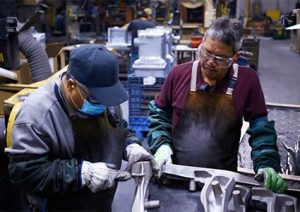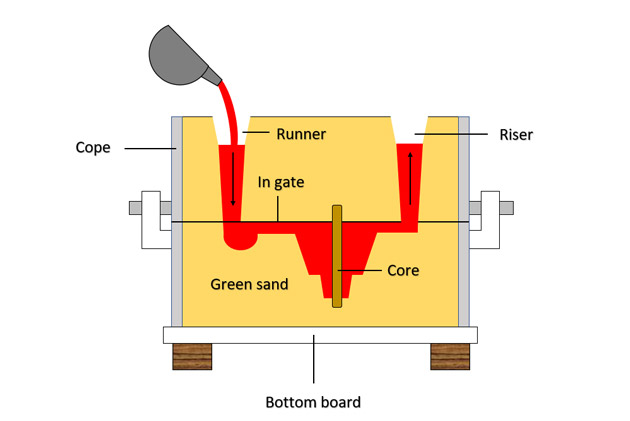Just How Aluminum Foundry Adds To Improvements in Aerospace Design
Aluminum foundries are important to developments in aerospace design. They create lightweight, high-strength elements that are crucial for modern-day aircraft. Via innovative casting techniques, these foundries develop intricate geometries that enhance architectural stability. Additionally, the advancement of remarkable Aluminum alloys sustains the market's emphasis on gas performance and sustainability. Difficulties stay in the manufacturing process. Understanding these elements exposes the profound influence of Aluminum on aviation's future.
The Relevance of Lightweight Products in Aerospace Design
As the aerospace market continues to develop, the relevance of light-weight materials ends up being significantly noticeable. The demand for performance and sustainability drives designers to prioritize using products that decrease general weight without endangering structural honesty. Lightweight materials, particularly Aluminum, play an essential role in boosting fuel effectiveness, boosting haul capacity, and increasing the overall performance of aircraft.
The combination of these materials permits for innovative styles, allowing makers to produce more wind resistant shapes that can stand up to extreme problems. The reduction in weight not only reduces functional prices but also adds to a reduced ecological footprint, lining up with global initiatives toward sustainability in air travel.
Advanced Casting Techniques in Aluminum Foundries
Advanced spreading strategies in Aluminum shops play an important duty in aerospace design by enabling the production of light-weight and specific components. Developments in mold design and precision spreading procedures are vital in achieving optimal performance and structural stability. Additionally, the advancement of light-weight alloys improves the overall performance and performance of aerospace applications.
Ingenious Mold Design
Cutting-edge mold design plays a crucial function in the effectiveness and performance of Aluminum factories, specifically within the aerospace field. By leveraging innovative products and methods, contemporary mold and mildews can be crafted to withstand heats and stress, ensuring peak performance during the casting process. These layouts typically incorporate complicated geometries that permit the manufacturing of lightweight yet structurally sound parts, vital for aerospace applications. In addition, the use of computer-aided design (CAD) software application promotes specific modeling, making it possible for shops to imitate and refine mold and mildew designs prior to physical production starts. This not only boosts the quality of actors components yet likewise minimizes waste and lead times, resulting in significant expense financial savings. Generally, ingenious mold and mildew style is a cornerstone of progress in Aluminum Foundry innovation for aerospace engineering.
Precision Casting Procedures
The efficiency of cutting-edge mold layouts seamlessly incorporates with accuracy spreading processes, which are necessary for producing premium Aluminum components in aerospace engineering. These procedures, consisting of sand spreading, pass away casting, and investment casting, assure the creation of intricate geometries with tight resistances. Advanced strategies like vacuum cleaner casting and stress pass away casting boost the integrity and surface area finish of the end products. Accuracy spreading decreases product waste while optimizing the mechanical buildings of Aluminum, critical for aerospace applications. Furthermore, employing real-time surveillance and advanced simulation devices throughout the casting process permits immediate adjustments, resulting in boosted quality assurance. Collectively, these precision casting procedures setting Aluminum factories at the leading edge of aerospace development, supporting the sector's need for integrity and performance.
Lightweight Alloy Development
As aerospace designers seek to boost gas performance and efficiency, light-weight alloy advancement becomes a crucial emphasis in Aluminum factories. These shops utilize advanced casting techniques to produce alloys that give exceptional strength-to-weight proportions. Developments in alloy make-up, including the consolidation of aspects like lithium and magnesium, make it possible for the production of products that withstand severe conditions while reducing total aircraft weight. Techniques such as die spreading and investment spreading assist in the precision production of complicated shapes, which are vital for aerospace applications. In addition, recurring study intends to optimize these alloys for boosted mechanical residential properties and increased toughness. By prioritizing lightweight alloy development, Aluminum foundries considerably add to the development of aerospace engineering, leading the way for more effective and lasting airplane styles.

Enhancing Structural Honesty Through Aluminum Components
Aluminum components provide substantial advantages in improving architectural honesty within aerospace engineering. Their light-weight nature contributes to overall performance while keeping strength, which is essential for aircraft performance. Additionally, the stress and anxiety resistance residential or commercial properties of Aluminum assistance ensure the resilience and reliability of aerospace structures under different functional problems.
Lightweight Product Benefits
While typical materials often compromise weight for stamina, utilizing Aluminum parts in aerospace design provides significant advantages in structural honesty. Aluminum's lightweight nature contributes to overall layout effectiveness, permitting more streamlined aircraft that consume less fuel, therefore boosting sustainability. The material's exceptional strength-to-weight ratio guarantees that components keep toughness without adding unneeded mass. This quality fosters improved performance and dexterity in flight, as well as maximized payload capacities. Furthermore, Aluminum's resistance to deterioration prolongs the lifespan of aerospace frameworks, decreasing upkeep prices and enhancing safety and security. As producers progressively embrace Aluminum alloys, the aerospace industry experiences a transformative shift towards a lot more reliable and effective engineering solutions that prioritize both performance and environmental responsibility.
Anxiety Resistance Features
Numerous products have one-of-a-kind homes, Aluminum's remarkable tension resistance stands this contact form out as an essential aspect in boosting the structural stability of aerospace parts. This resistance plays a vital role in making sure that aircraft can stand up to numerous operational stresses, including fatigue, influence, and ecological problems. Aluminum alloys, particularly crafted for aerospace applications, exhibit high tensile toughness while keeping lightweight qualities, allowing designers to make extra effective structures - Aluminum Foundry. Additionally, the capacity of Aluminum to withstand cyclic loading without significant deformation contributes to the longevity and integrity of aerospace components. As advancements continue in Aluminum Foundry techniques, the growth of stress-resistant Aluminum elements promises more renovations in efficiency, safety and security, and efficiency throughout the aerospace market, solidifying Aluminum's duty as a preferred material in modern-day design
Gas Performance Improvements Driven by Aluminum Innovations
As the aerospace industry seeks to enhance fuel effectiveness, innovative uses Aluminum have actually become a crucial remedy. Aluminum's light-weight nature especially reduces airplane weight, permitting for reduced gas intake during flight. This decrease in weight is vital, as even little declines can lead to considerable renovations in total gas economic situation.
Advanced Aluminum alloys, developed for improved strength and resilience, enable makers to produce parts that keep structural honesty while minimizing mass - Aluminum Foundry. In addition, the combination of Aluminum in airframes and engine elements helps with enhanced aerodynamics, contributing to decreased drag and raised performance
The fostering of Aluminum in aerospace not just meets the need for fuel-efficient design yet additionally aligns with regulatory stress for lower emissions. As these innovations remain to evolve, they play a considerable function in establishing brand-new criteria for fuel effectiveness, ensuring that the aerospace industry can satisfy growing environmental and financial challenges.

The Role of Aluminum in Sustainable Aeronautics Practices
The increasing focus on sustainable aeronautics techniques has placed Aluminum as an essential product in the pursuit for greener aircraft design. Understood for its lightweight buildings, Aluminum significantly reduces airplane weight, causing lower fuel consumption and emissions. Its recyclability better enhances its sustainability account, as Aluminum can be reused forever without loss of top quality. This particular supports a round economic situation within the aviation market, decreasing waste and source depletion.
In addition, developments in Aluminum alloys have enhanced their stamina and rust resistance, enabling longer service life and reduced upkeep needs. These developments facilitate the development of much more reliable airplane frameworks, adding to total sustainability efforts. Furthermore, Aluminum's thermal conductivity plays a critical role in energy-efficient styles, enhancing systems such as heat exchangers. Collectively, these qualities highlight Aluminum's essential function in advancing sustainable aeronautics, lining up with global efforts focused on lowering the ecological effect of air travel.
Difficulties Dealt With by Aluminum Foundries in Aerospace Manufacturing
While Aluminum foundries play a vital function in aerospace production, they face considerable difficulties that can influence manufacturing efficiency and quality. One major difficulty is the rigorous quality assurance criteria required in the aerospace industry. Any kind of problem can compromise safety and security and performance, necessitating strenuous inspection procedures that extend production timelines. Additionally, factories commonly contend with changing website here resources expenses, which can affect rates and earnings. The intricacy of Aluminum alloys made use of in aerospace applications further complicates the manufacturing procedure, as precise solutions are important for achieving preferred mechanical properties. Skilled labor lacks hinder the capacity to maintain top notch manufacturing degrees. Ultimately, environmental regulations enforce constraints on exhausts and waste monitoring, calling for foundries to buy lasting methods, which can be cost-prohibitive. These factors collectively develop a landscape where Aluminum shops must constantly adapt to fulfill the progressing demands of aerospace production while making certain safety and security and conformity.
Future Patterns in Aluminum Applications for Aerospace Engineering
With developments in technology and boosting needs for performance, the future of Aluminum applications in aerospace design is poised for significant transformation. The integration of ingenious Aluminum alloys and compounds is anticipated to enhance strength-to-weight proportions, bring about even more fuel-efficient aircraft styles. Additionally, advancements in additive manufacturing strategies will certainly permit the production of complex Aluminum structures that were previously difficult, optimizing efficiency and minimizing waste.

Sustainable techniques will play a necessary role, with an expanding emphasis on recycling Aluminum to minimize environmental influence. The aerospace market is most likely to accept smarter manufacturing procedures, such as automation and fabricated intelligence, making certain better and precision in Aluminum elements. Furthermore, collaborations in between Aluminum factories and aerospace companies will foster research study and development, leading the way for brand-new applications that meet the strict demands of contemporary aerospace design - Aluminum Foundry. Generally, the future looks guaranteeing for Aluminum's duty fit the skies
Frequently Asked Concerns
What Are the Ecological Effects of Aluminum Manufacturing in Aerospace?
The environmental impacts of Aluminum manufacturing in aerospace consist of considerable energy usage, greenhouse gas discharges, and habitat interruption. Additionally, mining processes can lead to soil degradation and water contamination, elevating worries concerning sustainability and ecological equilibrium.
Exactly How Does Aluminum Contrast to Various Other Products in Aerospace Applications?
Aluminum supplies a special mix of light-weight residential or commercial properties, deterioration resistance, and cost-effectiveness compared to other materials. Its high strength-to-weight ratio makes it specifically beneficial for aerospace applications, improving fuel effectiveness and general performance in aircraft layout.
What Credentials Do Aluminum Foundry Employees Requirement for Aerospace Projects?
Aluminum Foundry workers require specific training in metallurgy and spreading techniques, in addition to knowledge of aerospace industry standards. Certifications in quality assurance and security protocols are likewise important to ensure conformity with strict aerospace project needs.
Are There Any Type Of Safety Interest In Using Aluminum in Aerospace Design?
Security worries relating to Aluminum in aerospace engineering consist of vulnerability to tiredness, deterioration, and tension fractures. Appropriate treatment and alloy option are necessary to alleviate these risks, making certain structural stability and overall security in aerospace applications.
How Does Aluminum Recycling Advantage the Aerospace Market?
Aluminum reusing significantly benefits the aerospace industry by reducing material prices, decreasing ecological influence, and saving energy. This lasting technique improves the sector's efficiency while advertising using light-weight, high-performance elements in aircraft manufacturing.
Advanced casting strategies in Aluminum shops play an important role in aerospace design by enabling the production of exact and light-weight components. Ingenious mold and mildew style plays a crucial duty in the performance and performance of Aluminum shops, particularly within the aerospace market. As aerospace engineers seek to boost gas performance and performance, lightweight alloy advancement becomes a crucial focus in Aluminum foundries. Aluminum alloys, particularly engineered for aerospace applications, show high tensile stamina while keeping light-weight features, enabling engineers to develop extra efficient frameworks. Cooperations in between Aluminum factories and aerospace companies will promote research study and development, leading the means for brand-new applications that meet the stringent a fantastic read needs of modern aerospace engineering.